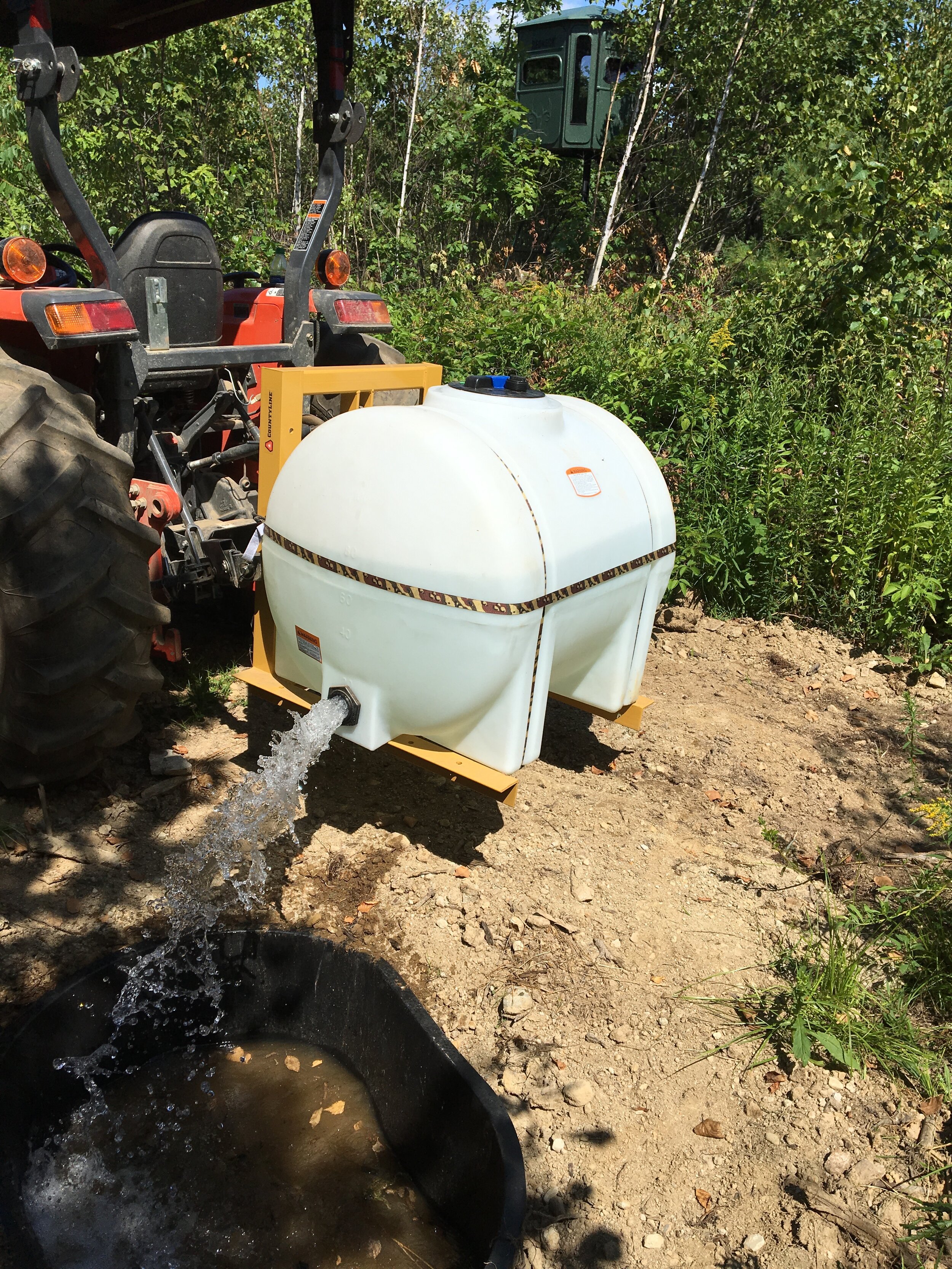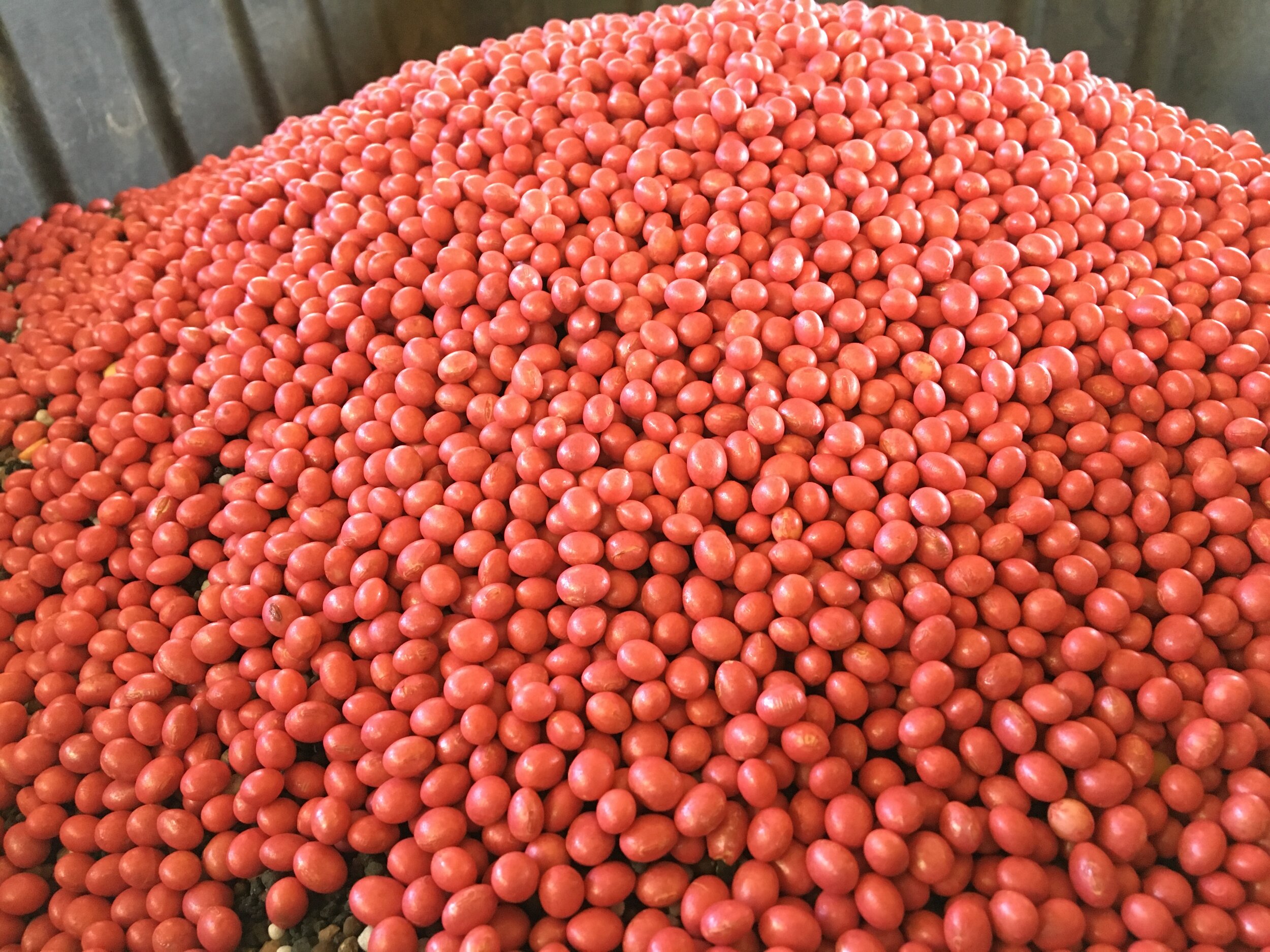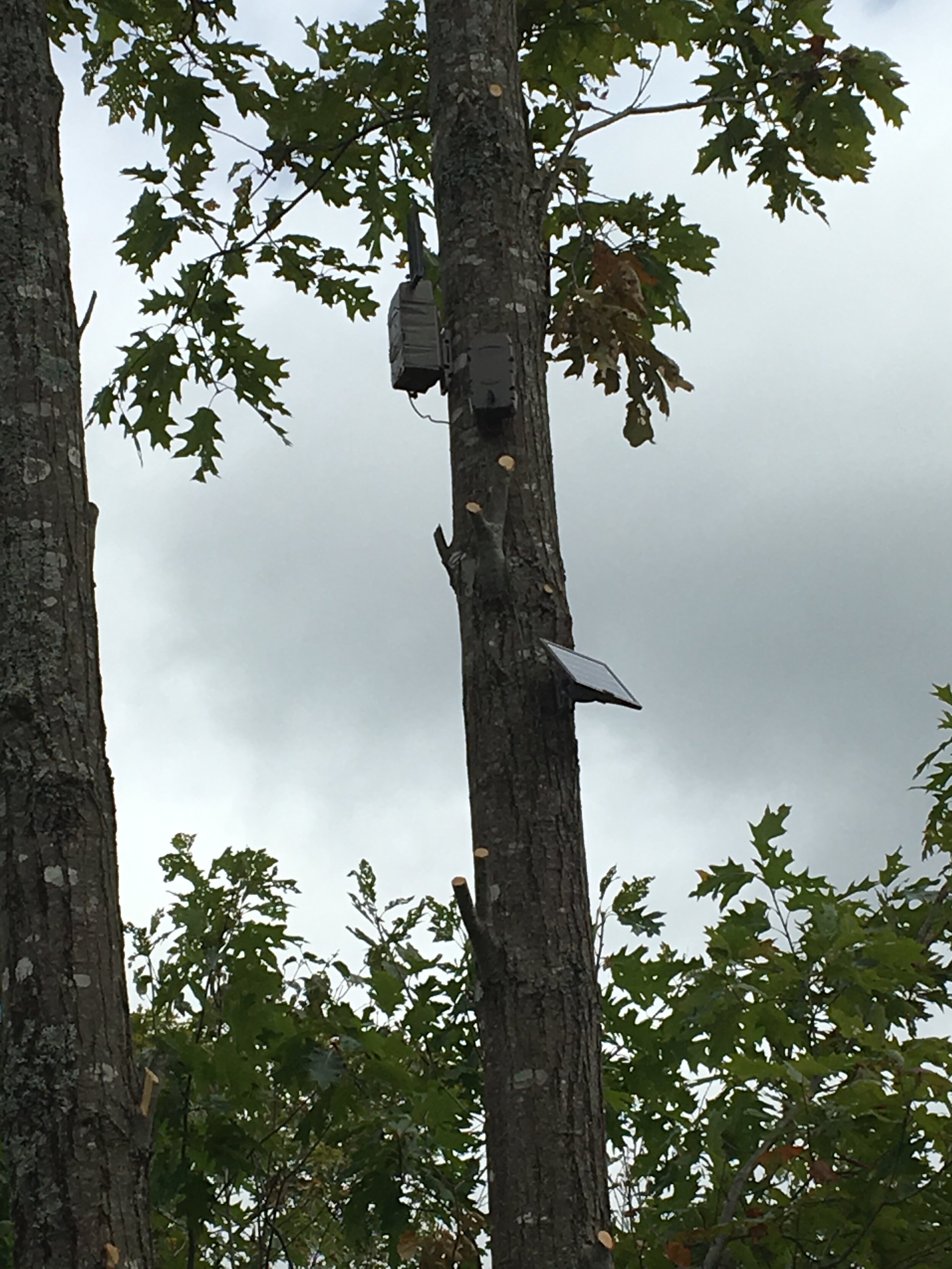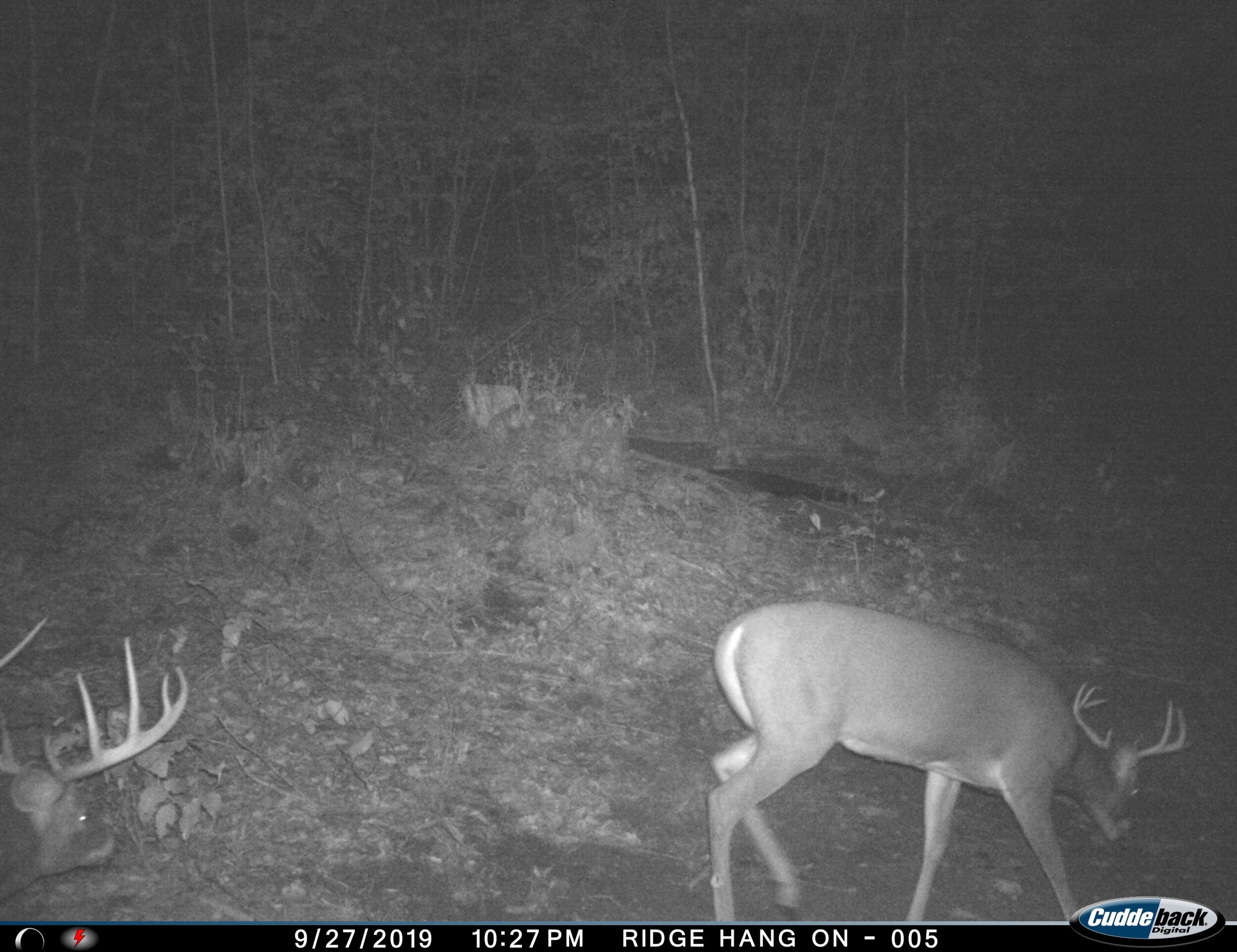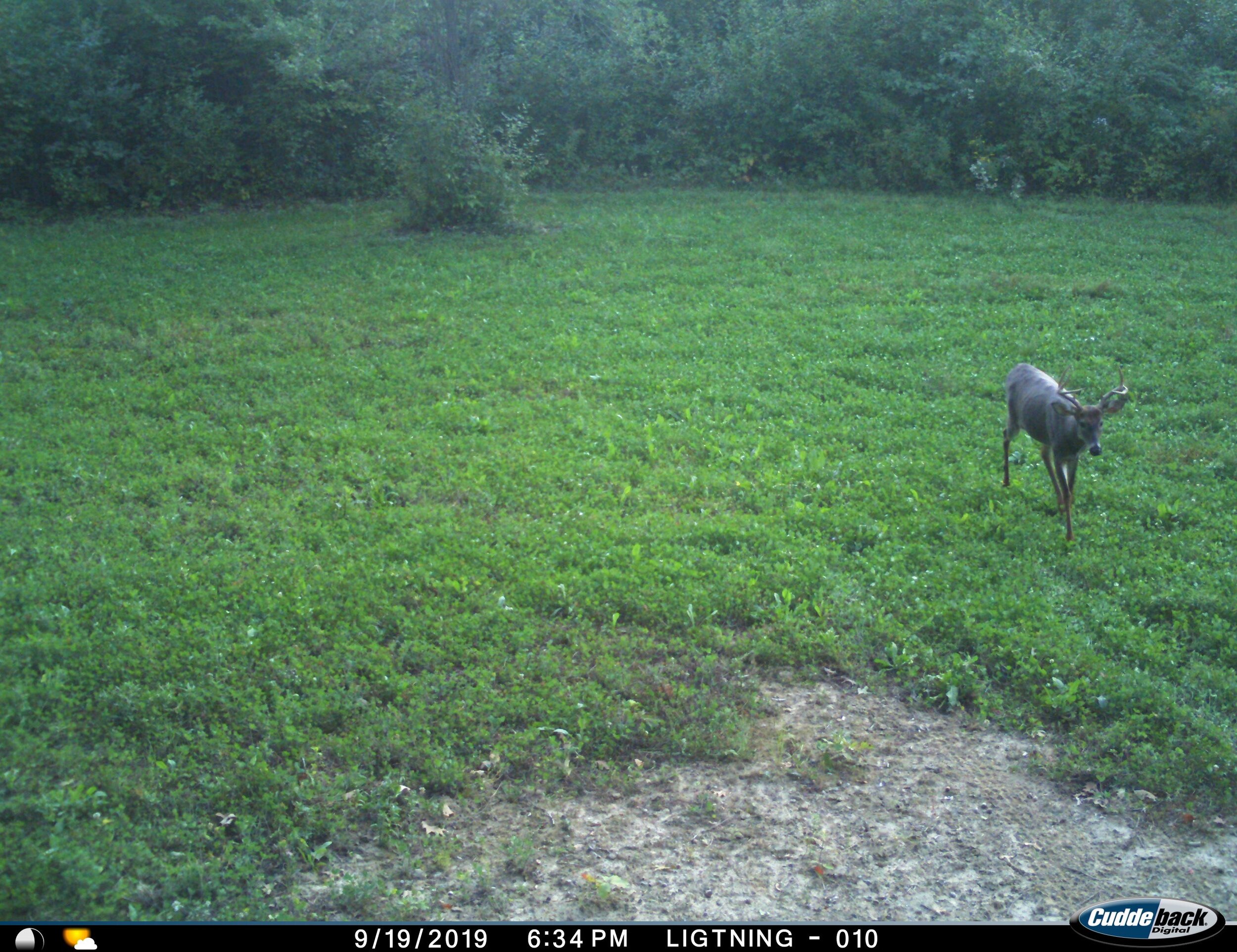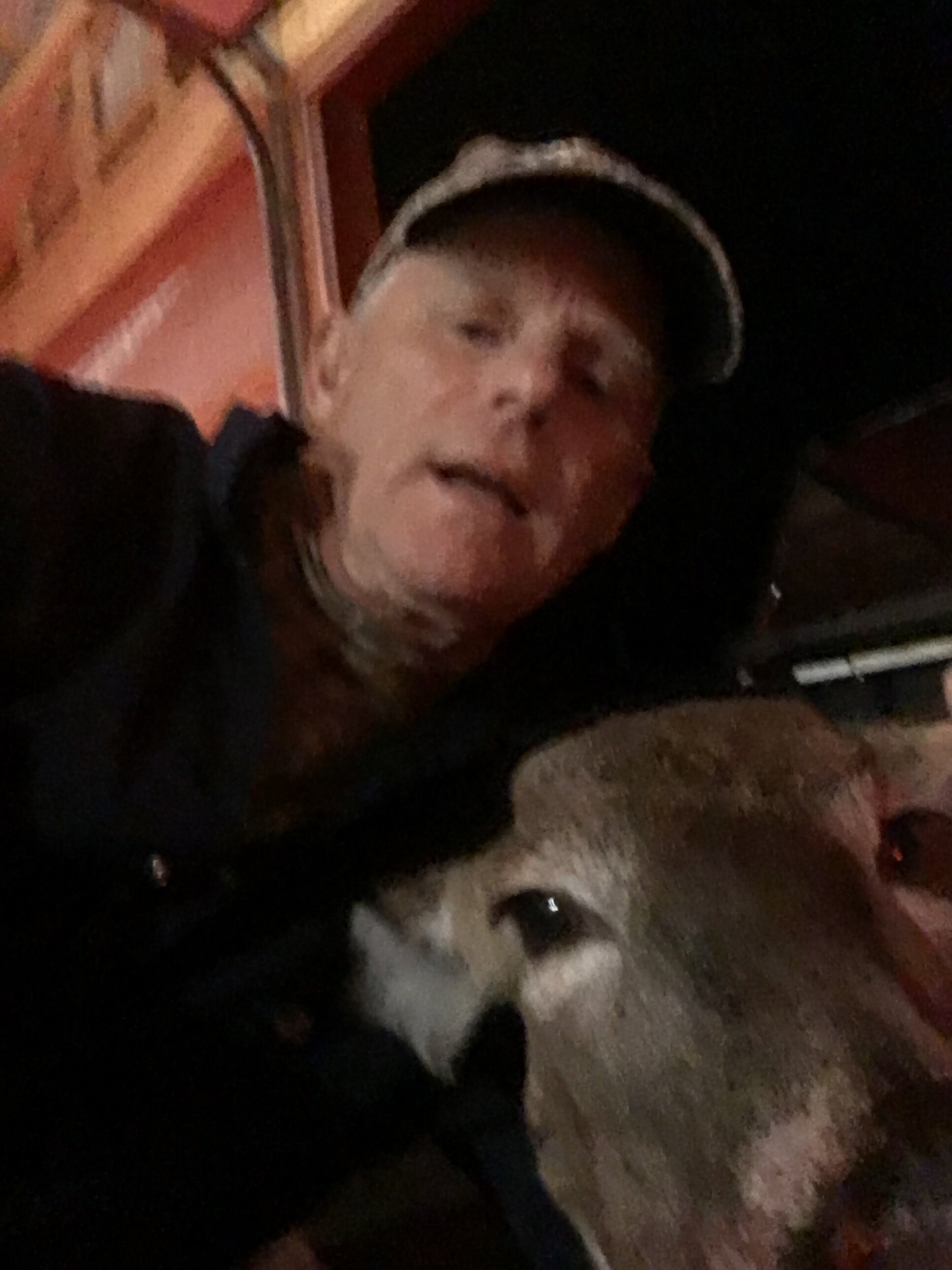2019 Land Management Case Study
The plan for 2019 - lots of hinge-cutting, trail cutting, redoing food plots, tree stands and new box blinds
Over the past five years I’ve put in a lot of hard work on my land and made solid progress. Back in 2014, when I purchased it, the original 61 acres offered deer daytime bedding cover due to the saplings and bushes that had taken over the logged land - there was browse for midday feeding but it wasn’t adjacent to a great afternoon food source. In 2017 when I purchased it, the 47 acre section was all dark woods with very little cover or browse, and deer weren’t spending much time on it. I probably had a total of 10 deer bedding on the 108 acres, and they left in the afternoon to find acorns or grass. I didn’t have a predictable travel pattern for the deer and no obvious places to hunt.
At the start of 2019 the original land had about 3 1/2 acres of food plots, good bedding cover adjacent to the food, hinge-cut barriers to direct the deer movement, and 10 tree stands. The 47 acres purchased in 2017 now had seven acres of food plots, 20 acres of selective cut that would soon generate bedding cover and browse, 20 acres of woods in patches between the cut areas, and one tree stand. The combined 108 acres had a total of 10.5 acres of food plots, and that forage was attracting about 20 deer that were now spending most of their time on my land.
Does like to bed close to their afternoon food source, and bucks like to be farther away so they don’t get bothered by other deer. I knew that I had large doe groups bedding southwest of the barn, south of the Big Clover plot, and south of the Big Field - each of those areas held 3 to 6 does at any one time. I had found beds and rubbed trees, evidence of buck bedding, along the ridge that runs across middle of the original 61 acres, and I had seen bucks coming out of their beds to the northeast of the Big Field and from the south of the Big Clover plot.
The tractor road was now a thick chocolate mess!
My plan for 2019 was to redo the Ledges and Pond food plots, put in a new food plot on the eastern edge of the Big Clover plot, replant the two one-acre annual plots in the Big Field, cut a bunch of trails and barriers to direct deer movement, hang a few tree stands, and put up two box blinds that would enable me to hunt in spots where there weren’t suitable trees. It was an ambitious plan, but I thought I could get most of it done.
Ahh, the problem with plans … The early spring of 2019 was wet, wetter than I’d seen it since buying the land. The central tractor road that ran almost a mile north-south was the way I got my tractor and materials from the barn to the various food plots, and this year it was a soupy mess. I had constructed it out of available materials, and it had been ok over the past five years, but now it wasn’t draining well at all. There were mudholes and ditches that were practically impassable so, before I could redo food plots or bring in box blinds and their metal towers, I needed to fix the tractor road.
Hinge-cutting a barrier by hand
Much of my time this year would be taken up with spreading the 12 truckloads of gravel I would have to buy. 12 dump truck loads times 18 yards per load equals 216 yards of gravel. My tractor bucket is six feet wide and holds maybe 1/2 of a yard, so that would be more than 400 loads. In the end I wasn’t able to spread all the gravel in 2019, saving some for the spring of 2020, but I probably spread close to 300 loads. The routine was scoop up a full bucket, carefully drive to the spot that needed the fill without spilling or tipping over, dump the load, backblade with the bucket, every few loads smooth with the rake, and repeat. As you work, the distance between the pile of gravel and the place you dump it gets longer, and each trip takes more time. Many hours for introspective thought.
When I wasn’t spreading gravel, I worked on cutting game trails and hinge-cutting barriers to better direct the deer traffic. My plan called for several trails and barriers, but the eastern side of the original parcel was my priority because this was where the bucks were bedding. I wanted to cut a trail that would run from the Ledges plot to the eastern end of the Big Clover plot, and use barriers to make that trail the path of least resistance. I hoped to funnel deer along the trail and hunt them from spots at either end and along the way. Hinge-cutting on that side was extensive, close to 1/4 mile of it, and it was back breaking. The trees in this area are too small for a chainsaw, but hard work for a handsaw - especially the hard red oaks that had grown in clumps from old oak stumps. The barrier I created was about 20 feet wide, so the deer would much rather take the trail around the barrier than try to jump through it.
Buck rubs littered the ridge
When cutting the trail from Ledges to Big Clover I found that the north section had the right topography to make a wider trail using a chainsaw and tractor. I roughed it out with the chainsaw and then bushhogged it, and the result was a good trail that followed the contours of the ridge down to the Ledges. It also had a fork that led down to the property line and the oak grove that started just beyond on my neighbor’s land. I planned to put up a tree stand near the property line at the end of that fork.
Heading south from the Ledges, the new wide trail climbs steadily uphill until you get to the top of the ridge where a logging road forms a junction from the west. This is the spot where I put a camera the previous year and got a bunch of photos of mature bucks in daylight. The bushhogged trail would have to change here to a hand-cut trail the rest of the way south to Big Clover. As I cut the trail to Big Clover I knew I was working across a hillside where bucks had been bedding during the previous season. I found rubs all over the place and several beds - my hope was that the bucks bedding here during the hunting season would take one of my trails out of here in the afternoon, putting them in front of a stand during shooting light. At the junction of trail and logging road was one place where I wanted to hunt and, since there wasn’t a great tree here, I was planning to erect one of the box blinds.
Redneck’s 6x6 Buck Palace at the junction
My friend Jeffrey Hintz in Wisconsin is a fan of box blinds, especially since they allow his kids to hunt with crossbows without their scent or movement spooking deer. I had two spots that I thought would be promising this year, but didn’t have suitable trees for a stand. The trail junction at the top of the ridge had great buck movement the previous year, accidentally caught on camera because I had needed a Cuddelink camera there to repeat the signal from other cameras to the home.
The other spot was the east end of the Big Clover plot - I knew that many deer staged in that plot in the late afternoon, browsing on clover before traveling to evening food sources, and I planned to install a food plot on that eastern end with a mix of annual forage that might entice deer out of the clover and over close to the blind. Barriers and trails converged there in an effort to move deer to that new plot.
Hintz recommended Redneck brand box blinds, so I ordered two of the Buck Palace blinds that are 6 feet square, along with two 10-foot steel towers. I ordered directly from the company and it wasn’t very long before their driver Bud dropped them off and I was able to use the pallet forks on the tractor bucket to move them into the barn. Assembling the towers is the tedious part of getting these blinds up and in place, but a lightweight cordless impact wrench made it go faster.
The Redneck instructions say that the way to put a box blind and tower stand up is to assemble the whole thing lying down on it’s side and then tip it up into place, but Jeffrey recommended that I consider putting the stand in-place first, and then setting the blind on top of it with my tractor. This appealed to me because I didn’t have four strong friends to help tip it up, and the spots I had in mind would have made that difficult because the blinds would be set into woods and brush. On the other hand, I measured how high I could get the pallet forks off the ground, and I would be about a foot short of the top of the 10 foot tower. The solution was to dig the tower into the ground, using my backhoe, and to set the blind on multiple pallets to get it even higher than one pallet alone. The result was a very secure tower that couldn’t possible tip over in a high wind, and the blind would be about 9 feet off the ground - plenty high enough for my purposes. To read my review of the Redneck Buck Palace, click here.
Filling one of my six waterholes
Jeff Sturgis is an author and has an active consulting business advising hunters how to improve their land. He advocates creating a travel pattern for deer around your land, and using various techniques to get them to frequent your stand locations during hunting hours. One of his favorite strategies is to construct a waterhole near your stand so deer will stop for a drink on their travels - this could be especially effective in dry areas and during the rut when bucks are constantly on the move. Waterholes are best placed in wooded areas where there isn’t a food plot and the deer are cruising through. I had several stand locations that were in the woods and not near water, so I thought that putting in a waterhole could make sense.
I purchased six 110 gallon heavy-duty plastic stock tanks from Tractor Supply, and dug the holes with my backhoe. It was easy to place the stock tanks in the holes and backfill to get the rim even with the ground level. To fill them, I took a carryall frame that attaches to my tractor’s three-point hitch and ratchet-strapped a 125 gallon storage tank to it - when filled with water, the tank’s drain hole would shoot water into the buried stock tank. In no time at all I had six waterholes scattered around my property. I made sure to put a log or branch in each waterhole, leaning against the edge, to enable any rodents that fell in to climb out and not ruin the water.
I used my dump trailer to bring manure back to the new food plot
My farming plan this year was to redo the Ledges and Pond food plots, redo and expand the Barn plot, create the new plot at the east end of the Big Clover Plot, and plant two of the Big Field plots in annual forage. The total was about 3 1/2 acres of planting, which didn’t seem to be too bad. I would need to start by spraying the redo plots to kill whatever was currently growing there, use the disk harrow to till the ground, use the rock picker to remove any rocks kicked up by the harrow, and add organic material to the new plot, Ledges, and Barn Expansion.
The spraying and disking went fine, but the rock picker stopped working due to a hydraulic pump problem in the tractor - my schedule was too tight to take the tractor in for service, so the rock picking would have to wait for another year. I used my landscape rake to work the rocks to the edge of the plots and then scooped them up with the bucket. A lot of topsoil also got scooped up and set aside, but maybe I would be able to recover that in the future with the picker. I brought in cow manure and staged it by the barn. Using my dump trailer, I brought loads of manure out to Ledges and the new plot, spreading it around with the tractor bucket and working it into the soil with the rake. All the plots were now in good shape for planting.
Forage soybeans sure are pretty
Meanwhile the very wet spring had changed to a very dry summer. I would normally plant my annual food plots in early to mid August, so I kept a close eye on the forecast looking for the weather to change and a spell of rain to move in. Finally, at the very end of August, I felt that I had waited as long as I could and would need to get seed in the ground regardless of how it did. If the drought continued I would still have my perennial clover and alfalfa to keep the deer around, though there would be several stands that would not have any attractive forage.
Jeff Sturgis advocates planting all of your food plots in a mix of winter peas, forage soybeans, oats, radishes, and brassicas. His logic is that if all your plots have the same annual mix, the deer will be distributed evenly and you will have more hunting opportunities. A possible weakness in this strategy is what I was experiencing in 2019 - a drought could cause all your annual plots to fail and then where would you be?
Annual mix on left, perennial clover right. Drought caused the annuals to get off to a slow start - glad I had the clover!
I planned to plant the two food plots in the Big Field, as well as the Barn plot, in the Sturgis mix, and then try different annual mixes in the other three redo plots. The Barn Extension would be planted in perennial clover, so in the future the plots around the barn would always have some draw. I have three treestands around the barn and, because of the does that bed nearby, it is a promising place to harvest a deer.
I decided to experiment with three annual mixes made by the Whitetail Institute. The Pond plot would be planted with No Plow, the Ledges would get Beets & Greens, and the new plot would have Pure Attraction. Hopefully I would get a good idea of how these three products performed in my area.
I planted all my plots by the beginning of September and it was more work than I expected. Each seed mix and food plot had to be treated separately. Each time I seeded a plot I had to mix the seed with enough lime and/or fertilizer to fill the spreader. The larger seeds, such as winter peas, oats, and soybeans needed to be very slightly tilled into the dirt with the disks set parallel. Smaller radish and brassica seeds needed cultipacking before and after spreading the seeds.
Deploying Cuddelink Cell
In addition to all that, the Sturgis plan called for spreading 700 lbs. of winter rye several weeks after the first seeding! But I couldn’t use a tractor to spread the rye - because of the young plant growth at this time, the rye needed to be sown using a hand operated spreader. Annuals are a lot of work! Perennials are planted once and might last five years - somehow I needed to streamline the annual planting.
Over the years I have used an EV-N-SPREAD by Earthway to spread clover seeds. I had poor results as the tiny seeds would shoot out of the spreader in a wave with every crank of the handle. To spread 700 lbs. of winter rye with the Earthway spreader would be a drag, so I looked at other spreaders online. I chose the Solo chest-mount spreader with a 20 lb. capacity based on the strong reviews. I was not disappointed. The Solo spreader sends an even spray of seeds, is comfortable, and smooth to operate. Spreading the 700 lbs. of rye was really not as bad as I anticipated. To read my review of the Solo Model 421 Chest-mount Spreader, click here.
The solar powered home base
The 2019 deer hunting season in the Maine Expanded Archery zones started September 7th. My annual plots were planted so I usually spread gravel in the morning and hunted in the afternoon - deer knew that my schlepping gravel on the central tractor road wasn’t a threat to them so, as long as I kept the tractor action to the mornings, I didn’t think it would bother my afternoon hunting. As usual, I took careful account of the wind direction and hunted the plots that I could get in and out of without spooking other areas. This meant hunting around the barn on the north side, or near the entrance in the south. The Barn Plot and Barn Extension had just been planted, and there hadn’t been the usual perennial clover there over the summer, so I wasn’t getting much action. The new ladder stand at south entrance was just off the field in the woods, and I really didn’t expect action there until the rut, so that was more of a way to glass the Big Field to see where the deer were moving. What I needed was, as Mark Drury calls it, MRI - most recent information.
My Cuddeback system of wireless linked cameras had worked very well the previous year. (To read my review of the Cuddelink system, click here). I only had one camera to check, the other cameras sending their photos through the chain back to that one home camera, so I wasn’t regularly going to each camera to pull memory cards and spook deer. What I wanted to do this year was integrate into my system the Cuddelink Cell home base that would transmit all the photos to me via email. No more pulling the card in the home camera. The ability to keep tabs on my land - deer, trespassers, everything - from anywhere in the world!
The daily camera report emailed to me from the Cuddelink Cell system
Now that I had a lull in my other projects, I focused on deploying the Cuddelink Cell system. I wanted to locate the home base high up in a tree on the central ridge that runs diagonally across the original parcel - that way the signal from the remote cameras could easily reach the home base. I also didn’t want to be changing batteries up in that tree, so I purchased the solar panel and battery pack that, according to Cuddeback, can keep it going for years. It all went together easily and I soon started to get photos from the cameras located at key hunting spots around the 108 acres.
In mid-September I didn’t have all my cameras out so I was still hunting based on past experience. One afternoon the wind was out of the south so I decided to try hunting over the Instep plot. The wind would be blowing my scent behind the stand, toward the grove of oaks on the ridge. The two deer I’ve shot from that stand were bedded to the south in the thick stuff, so I expected any action to come from the bedding area up-wind.
To get to Instep I rode my e-bike out to the paved road, turned left and rode west to another road, took that south to a power line that continues south parallel to the west of my land. Riding down the power line I got to a point where I was just past about halfway down the west side of my land. I hid the bike in the woods, locking it to a tree, and then cut through the oak ridge to approach the Instep stand downwind from the northwest. As I quietly walked to my stand I came across a fresh scrape that was big, at least six feet across - an excellent sign that bucks (looked like several of them) had been recently frequenting the ridge!
I had at least one bachelor group of older bucks living on my land
The treestand at the Instep plot is in a huge old oak, facing south overlooking the patch of clover that’s about a third of an acre, and the thick bedding cover is about 35 yards away in three directions. Tractor roads converge from the north, east, and west, with the east road coming directly from the Big Clover plot that’s only about 100 yards away. The weather was clear, starting warm then cooling off sharply as the sun began to set. The old tree has a major limb that forks off at 10 feet off the ground, and this fork branches many times like it’s own tree - the stand is another 10 feet above the fork, so the branches and trunks give a tremendous amount of camouflage to the hunter. I have been able to move freely in that stand and not been busted by the deer that were feeding in the plot below.
It was an early season hunt so I brought lightweight camo clothing. I was wearing a fleece hoody and, as the temperature dropped, I put on a lightweight zippered jacket with a hood. I began to get cold so I put up the fleece hood, and then the jacket hood on top of it, as I waited for the action that I expected to come from the thick bedding area in front of me. Just after sunset I saw movement off to my far left - three bucks were walking in on the road that comes from the Big Clover plot! Instead of feeding in the plot in front of me, these jokers were going to walk by to the extreme left of my stand. This wasn’t the plan!
10 point joker that did not follow the script
They were close - later I would range the distance at 23 yards. I grabbed my bow, hooked my release, and got ready to draw. The first buck and the third buck looked to be younger, probably 2 1/2 years old, but the middle one was definitely bigger, older and with a larger rack. They were walking steadily, so I only had time to make a quick assessment, pick my target, and draw. I had never had a deer come in from the far left of the stand and wasn’t really ready for this scenario, but my bow cleared the limb easily and I went to anchor my release on the side of my face as I normally do. Wait! Something was wrong!
I couldn’t see my target through the peep in the string! The two hoods were keeping the release away from my face so my eye wasn’t lining up with the peep. I was at full draw, so there was no way to fix the situation. I had no choice but to let down. The bucks continued walking - the dream of harvesting a mature buck on my own land would not be happening today. Bowhunting is a game of small details, and a rookie mistake, not practicing my draw with both hoods up, was the detail that kept me from success that day.
Catch the 6:34 PM buck express
Later in the season I figured out that this bachelor trio of bucks had been bedding in the cover just south of the Big Clover plot. They had eaten their fill of green forage in Big Clover and were heading to the oak ridge for acorns when they passed my stand - that’s why they never stopped to graze on clover in the plot, and never gave me the shot I had planned for. I watched them under the oaks behind the stand until dark, out of range for another shot. I also noticed that several small branches might have been in the way of my arrow anyway - the kind of thing you don’t see when going through your shot routine. In the future I would want to locate another camera on this side of Instep, and cut some branches to make sure that I could shoot easily to the left.
I put my cameras out September 19th and the next day my email showed that a big buck had walked under my stand at the Lightning plot at 6:34 the afternoon of the 19th. I hunted from that stand on the 20th and, when 6:34 rolled around, my heart was beating out of my chest! If it was only that easy. Nothing showed.
Deer selfies are not easy - or good!
In October I noticed that I was getting consistent deer activity at the Ledges plot - both bucks and does. I had planted the Ledges with Beets & Greens and, of all of the food plots with annual mixes, this one was getting hit the most. When the wind was out of the west I hunted the Ledges for the first time. The stand there is also hung in an old oak, but this one isn’t as high and doesn’t have as much cover. When the sun set six does romped into the plot from the bedding area behind the barn - before I could stand and grab my bow. They fed in front of me as I tried to, ever so slowly, move my hand up and remove the bow from the hook it was hanging on. I moved, they froze, I froze, I moved - it was red-light-green-light and they began to get spooked. As they exited the plot to the south I was able to get the bow and draw from a seated position. I drew on the last doe and sent an arrow over her back. I overestimated the yardage and picked the wrong pin - a game of details. The deer weren’t too boogered by my shot, and I watched them feeding on acorns back in the woods until dark.
I started to convert my cameras to solar power
I hunted Ledges again the next week, and this time I knew what to expect. At sunset a line of deer filed toward me from the cover and I immediately stood and grabbed my bow before they were close enough to spot me. In a minute I had 10 does feeding in front of me, at a distance of between 10 and 30 yards. They were close and one or two didn’t like the blob up in the tree, giving me the hairy eyeball. I didn’t dare draw the bow - I was just trying to control my heart rate and breathing, holding the bow tight to my hip to keep it from shaking.
The largest doe was off to the right and I would have to shift my feet to be able to shoot in that direction - no way. There were a couple good size does close to the left, so that’s where I would go. As I drew the bow I could see in my peripheral vision the deer on the right immediately walking back toward the bedding area, but I was able to acquire my target and make a good shot. My deer ran up the hill toward the south, stopped, and tipped over, rolling to a stop just 45 yards away. She would weigh-in at 134 lbs., the largest doe I’ve ever shot - but not the largest in that group of ten.
I hunted the balance of the season with the hope of catching up again with that 10-point, or one of the several other nice bucks I’d seen on-camera, but that was not to happen. During the rut I had multiple yearling bucks chase does under my stand, which was hugely entertaining, but I learned my lesson about shooting young bucks and wasn’t even tempted - if you want to have old bucks on your farm you have to let the young bucks walk. Just before Thanksgiving I was hunting at the Ledges again when a doe came in right before dark. I made a great shot and she ran up the hill the way the other one had - I found this doe about 70 yards from the stand. The freezer was filled again.
Posted land, don’t ya know! I’m now getting photos of trespassers while I’m out of state
2019 was another successful year. I had accomplished most of what I had wanted to do during the year, finally had a shot opportunity at a mature buck, and put two does in the freezer. Spreading gravel had kept me from cutting all the trails or barriers that I planned, but I had done plenty of cutting. The waterholes didn’t seem to be working, but maybe they needed time. The Redneck blind I put at the trail junction hadn’t had any action, based on what little the camera had captured, but maybe all my cutting on the ridge, plus the addition of a big box blind, had spooked the deer. I didn’t even bother hunting from that blind, but I could move it to the Big Field next year.
The Cuddelink Cell system works really well. The photos and camera report are emailed to me at 4:00 AM each morning and it is fun looking at the photos over breakfast. I am on the month-by-month plan for 2,000 images and it cost $20 plus tax each month. This is for 15 cameras, so it is much cheaper than other systems that charge for each camera. I decided that I would leave some cameras out over the winter so I could see what was going on, but I would need to convert them to solar power so I wouldn’t have to deal with dead batteries. I did that late in the season and the results have been great - next year I will convert many more to solar and leave them out year-round. To read about how I deploy the Cuddelink Cell cameras with solar panels, click here.
To keep reading about my land management project: Click Here To Go Forward To 2020
To retrace your steps back to the previous year : Click Here To Go Back To 2018





